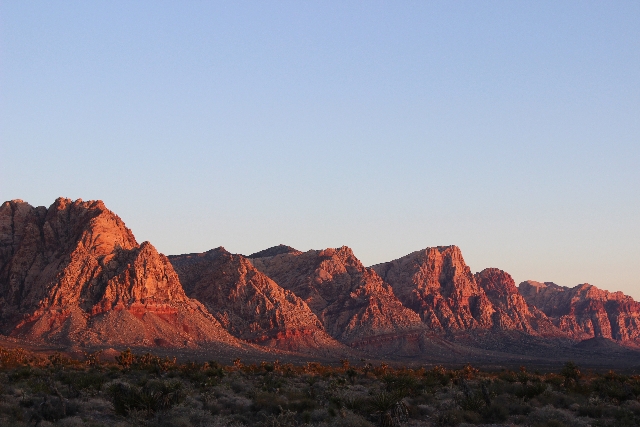Scenic drive, accessible overlooks provide a look at Red Rock Canyon
One of the best scenic drives in Southern Nevada starts only about a half-hour west of the Strip at Red Rock Canyon National Conservation Area. This colorful red, orange and yellow landscape, composed primarily of sandstone, is dominated by the towering Wilson Cliffs. The park, which encompasses about 200,000 acres, is managed by the Bureau of Land Management.
When first entering the park, you pass through a fee station. Here you can pick up a park newspaper, which includes a map and destination guide. For those with limited mobility, a good place to start your visit is at the Red Rock Canyon Visitor Center.
This center is completely accessible, including the parking, bathrooms, lecture rooms and the indoor and outdoor displays. Interpretive displays are found throughout the inside, but out the back door is where the park showcases its most interesting and creative information. There are four themed interpretive exhibits: earth, air, fire and water. The highlight here is the earth exhibit, which spotlights the park’s resident desert tortoises.
From spring through fall, if you are fortunate, you might be able to see one of these federally protected reptiles. Tortoises can spend 95 percent of their lives in their burrows, but they often live 60-80 years. There is an accessible paved trail along the perimeter of the tortoise area where the burrows are.
Once you leave the visitor center, head onto the 13-mile scenic drive, which is a one-way loop. This drive lets you see close-up views of the park’s highlights, including the Calico Hills, High Point Overlook, Willow Springs and the Wilson Cliffs. It isn’t just a drive, as there are plenty of accessible viewpoints and overlooks along the roadway to stop. If you have the time, relax on a bench, breathe some fresh air and take in the breathtaking views firsthand.
The highest elevation along the drive is the High Point Overlook, 4,771 feet in elevation, which affords one of the best panoramic views of the park. Here you will find an accessible parking area and plenty of viewing space to see the Wilson Cliffs, which rise more than 3,000 feet above the valley floor.
Another great place to stop is the Willow Springs picnic area, just off the main loop on the right. There is an accessible trail here and mature deciduous trees that not only shade the paths but also provide a sheltered place to sit, listen and look for birds. More than 150 species of birds have been identified in the park. Red Rock Canyon is also home to a lot of wildlife, including desert bighorn sheep, mule deer, mountain lions, coyotes and gray foxes.
Back in your vehicle, continue along the loop. As you travel, look to your right and you will find many deep side canyons that are flanked by sheer cliff walls. These highly vegetated canyons are sought by hikers and climbers from throughout the world. As you finish driving the loop, keep your eyes open for the resident herd of wild burros that are often seen along the roadway.
Once you reach the end of the scenic drive, go left, exiting the loop, and you will be back on state Route 159 toward Las Vegas. Drive less than a half-mile and on your left you will find the Red Rock Overlook. There is an accessible trail here, and the overlook offers another full panoramic view of the stunning Red Rock Canyon area. It’s one last chance to take in the natural beauty of the park before heading back to town.
National Access passes are accepted at this park. The scenic drive is open daily from 6 a.m. to 8 p.m. through September, with shortened hours the rest of the year. The visitor center is open daily 8 a.m. to 4:30 p.m. For more information on Red Rock Canyon NCA, call 702-515-5367 or visit www.blm.gov/nv.
Deborah Wall is the author of Base Camp Las Vegas: Hiking the Southwestern States” and “Great Hikes, A Cerca Country Guide,” published by Stephens Press. Dennis Boulton is a retired Nevada school teacher and geologist. They can be reached at deborabus@aol.com.






















